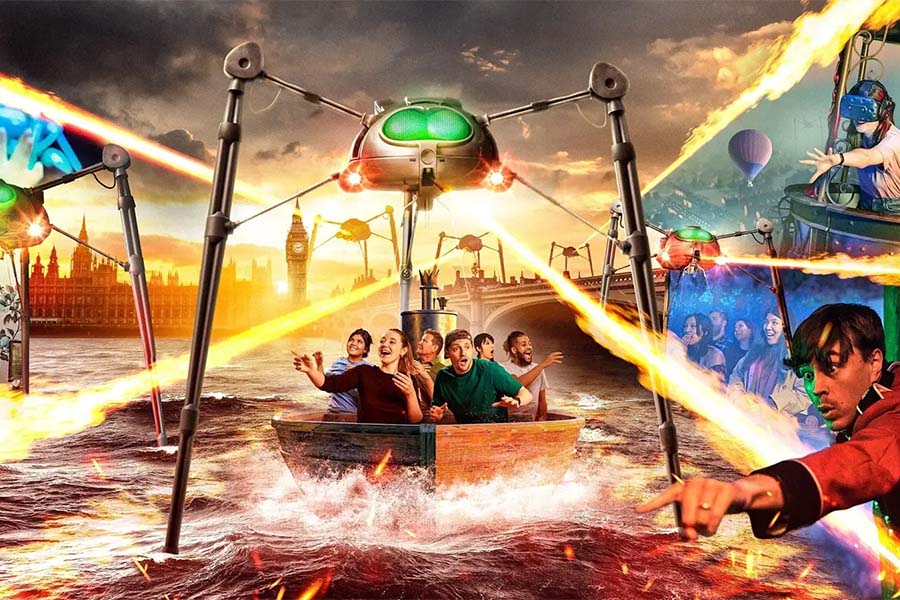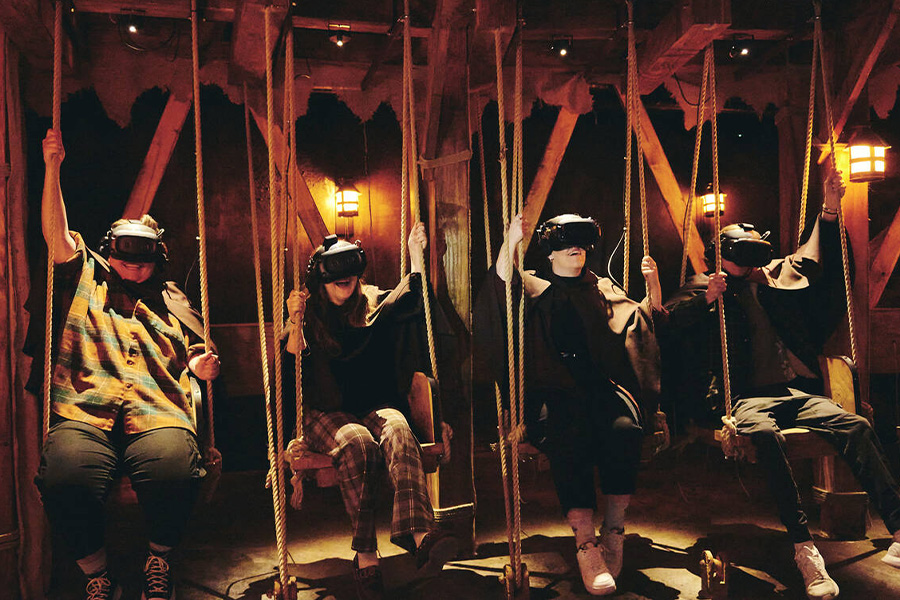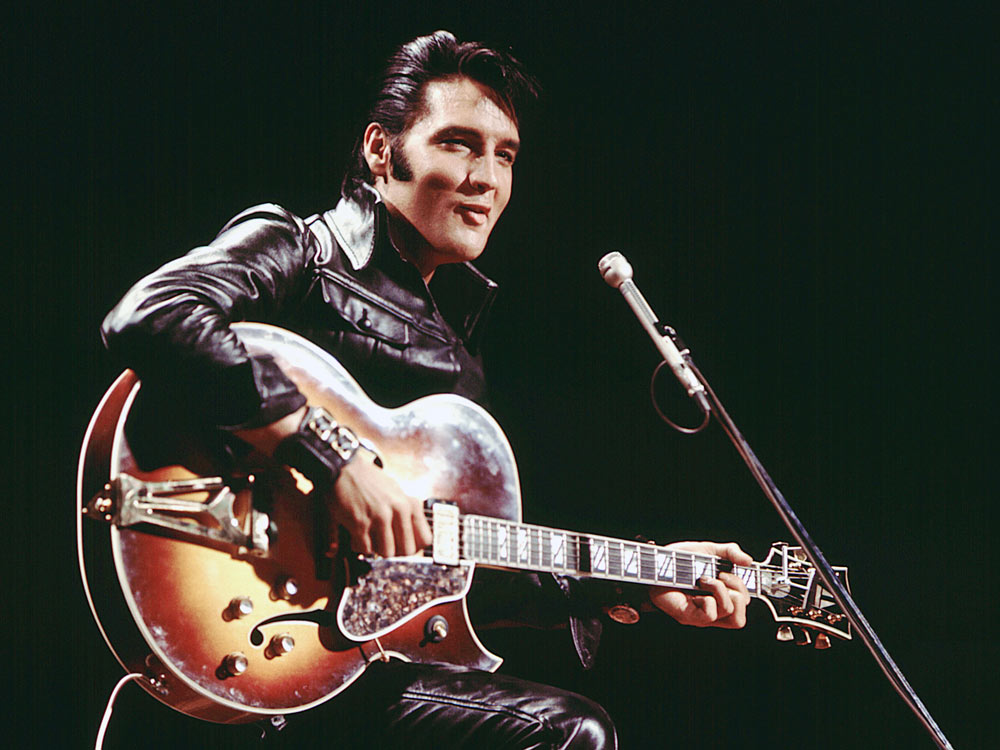How do you reinvent the past using the immersive technology of the future?
Blockbuster experiences like ABBA Voyage have proved that there’s a serious appetite for nostalgic entertainment, but with a futuristic twist. The more recent success of Rumble in the Jungle Rematch – the winner of the first World Experience Award for Art – also demonstrates that there’s a strong desire for audiences to relive massive cultural moments, whether in music, sport, or history.
So we’re very excited to hear that Elvis Evolution, a major new immersive experience celebrating the world’s biggest star of stage and screen, is set to launch in London in November 2024. The show is the work of Layered Reality, who created and operate London’s highest-rated immersive entertainment experiences, The Gunpowder Plot & The War of the Worlds.
Its Founder & CEO, Andrew McGuinness, shares how Layered Reality will be taking what they’ve learned from these previous blockbuster experiences to bring Elvis back into the building, using state-of-the-art multi-sensory technology – including VR, AI, and holographic projection – as well as thousands of the global megastar’s personal photos and home-video footage to recreate the King’s world.
The 3 Layers Of Storytelling

Whatever experience they’re creating, Layered Reality operates on three “layers” to build a compelling story:
1 Technology. This could mean AR, projection mapping, VR, volumetric holograms, or whatever emerging tech is at their disposal. McGuinness stresses that although technology is important, their experiences are “tech agnostic”: technology is a means to the storytelling, not an end in itself.
“We’re in the business of memory making. Tech helps us do that.” – Andrew McGuinness
2 Theatre. This includes live actors, special effects, movie-scale sets, and everything else you’d associate with a traditional live theatre show. The human element in particular is important – both the humanity of sharing the experience with the people you’re with, and your proximity to the person performing for you.
3 Physical Senses. This includes not just visual and audio, but also taste and smell, temperature, and touch. Some of these may be obvious, and others more subtle – smell is powerful for evoking memories, for example, and temperature can subliminally make people feel part of the action.
“You should bombard the senses so people really feel like they’re a participant – so they live the story.” – Andrew McGuinness
This reminds us of both the work done by Curtis Hickman on “magic design”, and the combination of technology, theatre and sensory stimulation in David Byrne and Andrew Scoville’s Theater of the Mind.
None of these layers are more important than the others. They work together, and all in service of the story. In the War of the Worlds, for example, participants walk into a boat yard where they can smell the sea, feel pebbles underfoot, and get into a heavy wooden boat, where they put on a VR headset that transports them into an identical, digital world. Here they can travel down the Thames, see the Martians blowing up the Houses of Parliament, feel the slight movement of the boat rocking, and feel the spray of water in their faces.
“All your senses are telling you that you’re in this space. It makes it great fun, but also convincing.” – Andrew McGuinness
Where a headset can often feel like a barrier or pull you out of the experience, here the transition is managed by integrating it into the script and acknowledging it’s there, so that the point isn’t over-laboured and people just go with it.
The spaces used for the shows are also large scale and are quite physical, to give guests a real sense of taking a journey. The War of the Worlds is around 25,000sq ft and involves 1.5km of walking, and Elvis Evolution will be a whopping 35,000sq ft.
Make Food & Beverage An Intrinsic Part Of Your Experience
In the typical West End or Broadway model for a show, someone else – an external restaurant or bar – usually profits from the guest’s desire for a drink before the show or meal after. This is a loss not only to the creators of that experience, but also to the guests, who find themselves in a generic space when they really want their night to be all about the experience they’ve chosen.
Consequently, Layered Reality always offers themed cocktails and food in a themed environment to capture this spend.
“From an economic point of view, that’s been quite transformational. Our revenue split is roughly two thirds on the ticket and one third on ancillary spend, so it’s a very big part of our business model.” – Andrew McGuinness
But for the guest, it also means the memory making can start with having a cocktail that’s unique and connected to the show.
“I believe that customers are looking for a great night out. They’re not looking for theatre, and they’re almost certainly not looking for ‘an immersive experience’. Their start point is much wider: to have something to eat or drink, do something they can talk about, remember it afterwards, and know what they spent was worth it.” – Andrew McGuinness
Customer Reviews Should Be The Bedrock Of Your Business
This customer-centric approach is borne out in Layered Reality’s attitude to customer reviews: they’re obsessed with them. Particularly in our era of immersive-washing, there’s a lot out there that isn’t very good. If someone’s going to spend their money on something unfamiliar, they want the confidence to do so – and reviews are the key to this.
The War of the Worlds is London’s highest rated night out, with an average TripAdvisor rating of 4.84. This not only gives the customer reassurance, but critically it also gives the rights holders the confidence that they’ll get a sackful of cash from you and you won’t mess up their brand.
Forget Touring: A Residency Space Really Matters!

Layered Reality’s first experience – a proof of concept called Somnai – took place in a “meanwhile space” in an East London warehouse that was awaiting development. They thought this would be a neat way to save money – but quickly learned that this was wrong.
“We quickly learned that what you spend on the boring stuff that the customer doesn’t really see – toilets, ventilation, air conditioning, etc – is disproportionate. You’re not going to make anyone’s night if you get it right – but you might well ruin it if you get it wrong.” – Andrew McGuinness
There were other learnings, too – they underestimated the importance of F&B, refusing to let people drink beforehand unless it affected the experience, and the group sizes of 6 people were too small to be economical.
They took these learnings into the War of the Worlds when opening in 2019. This was the first experience they ran in a repurposed space, taking a non-entertainment space – the previous London Metal Exchange – and turning it into an entertainment space.
“Increasingly in cities, there’s second-class office space lying dormant. This is an opportunity.” – Andrew McGuinness
(For more on this, see The Two Futures Of Experiential Retail: More-Than-A-Store & Experience Districts, and Your City Needs You: How Experience Design Will Save Our Cities.)
Their next experience, The Gunpowder Plot, was in an “amazing and painful” space, one of the ancient vaults on the site of the Tower of London. The space hadn’t been used for 20 years and was a pain to activate, with leaks and other operational challenges. However, it was still an amazing opportunity, because it was right next to a massive tourist attraction that draws 3 million visitors per year, and it also provided a further layer of history for the storytelling: the Tower of London is where the actual story began and ended.
“You’re not quite sure where the building begins and the sets end. It’s something in the walls, a sense of place.” – Andrew McGuinness
McGuinness also reflects that The Gunpowder Plot poses a central dilemma: are they protagonists traitors or freedom fighters? This challenges our notions of terrorists and gives people something to reflect on. While you can take a lighter approach, this moral dilemma can be an important hook – see Michael Badelt’s thoughts on this in Trojan Horses And Finding Meaning In Unlikely Places.
Taking These Lessons Into Elvis Evolution
All these learnings really helped shape the development of Elvis Evolution.
- Exceptional reviews open doors. Without the great reviews from War of the Worlds and The Gunpowder Plot, McGuinness doubts that they ever would have secured the rights to the Elvis story from the owners, Authentic Brands Group, who also granted the rights to Rumble in the Jungle. They, plus the Elvis family estate, were nervous about the kind of hackneyed Elvis impersonators that have flooded the market, and needed reassurance that people would have an incredible time in their hands. When the experience was announced in January 2023, the media response was incredible: McGuinness had 20 broadcast interviews in over 14 hours and the story was picked up around the world.
- Technology, theatre and the senses sit side by side. Around 50% of the costs for Elvis Evolution go into creating digital assets, so they can scale and take the experience to multiple cities and reduce operating costs, as well as do things within the story that would otherwise not be possible – a live performance by Elvis using AI technology, for example. However, by combining this with a physical cast, the experience is deeper all round.
- Themed F&B is an integral part of the experience. Elvis Evolution will have three bars representing different chapters of Elvis’s story at different points of the experience: a 1960s diner at the beginning, a “juke joint” interval bar with live music halfway through, and a glorious afterparty bar to celebrate his musical legacy.
- History offers us a chance to reflect on how far we’ve come. The Elvis story isn’t only about the musical worlds he inhabited, but also about the period of incredible transformation he lived through in the United States. His story poses questions about civil rights in the time of Martin Luther King, the Vietnam War, and the explosion in culture afterwards.
The Next Evolution Of Physical & Digital Integration
Layered Reality are also working on another new experience alongside Elvis Evolution. Dreamflyer London will let guests experience the dream of being able to fly a jetpack through some of the most iconic locations in the world, all set within a broader purpose and storytelling about how it might make humanity better.
“It’ll be very physical with lots of movement, wind effects, and scent The technology is quite extensive, but it’s all in support of the storytelling. And for the first time ever in an experience, you’ll transition from physical sets to a digital/AR overlay on the real world in a seamless way, so you won’t know when you’re stepping from a physical set enhanced with digital elements into a digital set.” – Andrew McGuinness
This experience will be shorter at 50 minutes, and at a more accessible price point of $25-30, as part of an experiment to see how to segment the market in a different way.
“We’re working our way to the ultimate goal, which is globally appealing, evergreen IPs with multigenerational appeal.” – Andrew McGuinness
The WXO Take-Out
Layered Reality’s experiments in building a widely appealing, highly rated, and financially sustainable experience offer some brilliant insights into how you might do the same. Of course, there’s no one correct answer – but their conclusions provide one way forward.
- Don’t obsess about seasonality or repeat visits – just focus on creating something great, which people will naturally want to come back to again and again.
- Technology is important and can allow you to do impossible things – but it’s no more important than the humans experiencing it and the memories they’ll make. What’s going to have a big impact? What needs to recede? And should that be done through tech, sets, actors, or something else?
- Your main experience should be the feature – but you should build an entire social experience encompassing food, drink and merch around this, both for your revenue and for the customer’s experience.
- Creating an experience that can scale and be taken to different cities and spaces is really important – but a residency also helps save time, effort and money on getting the fundamentals right each time.
So next time you’re creating an experience, ask yourself:
- What “layer” of technology, theatre, or physical sensation could you add?
- What moral choice could you pose your customer?
- What’s your revenue split – and where are there opportunities to make ancillary revenue an integrated part of your experience?
Want to come to live Campfires and join fellow expert experience creators from 39+ different countries as we lead the Experience Revolution forward? Apply to join the WXO today.





